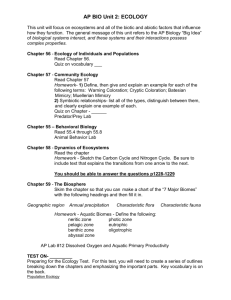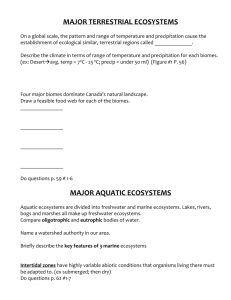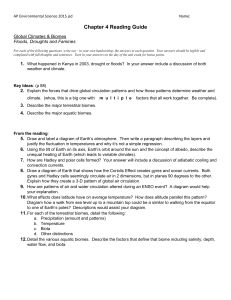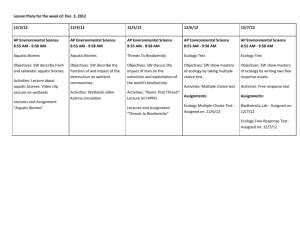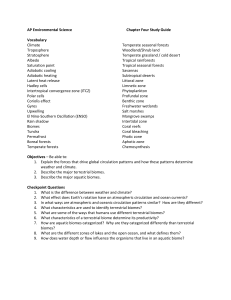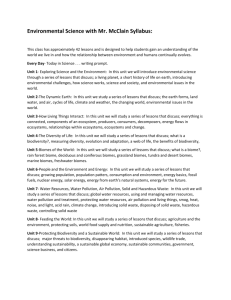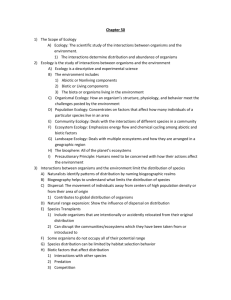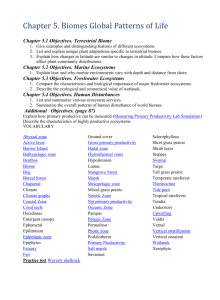Unit 11 Objectives
advertisement
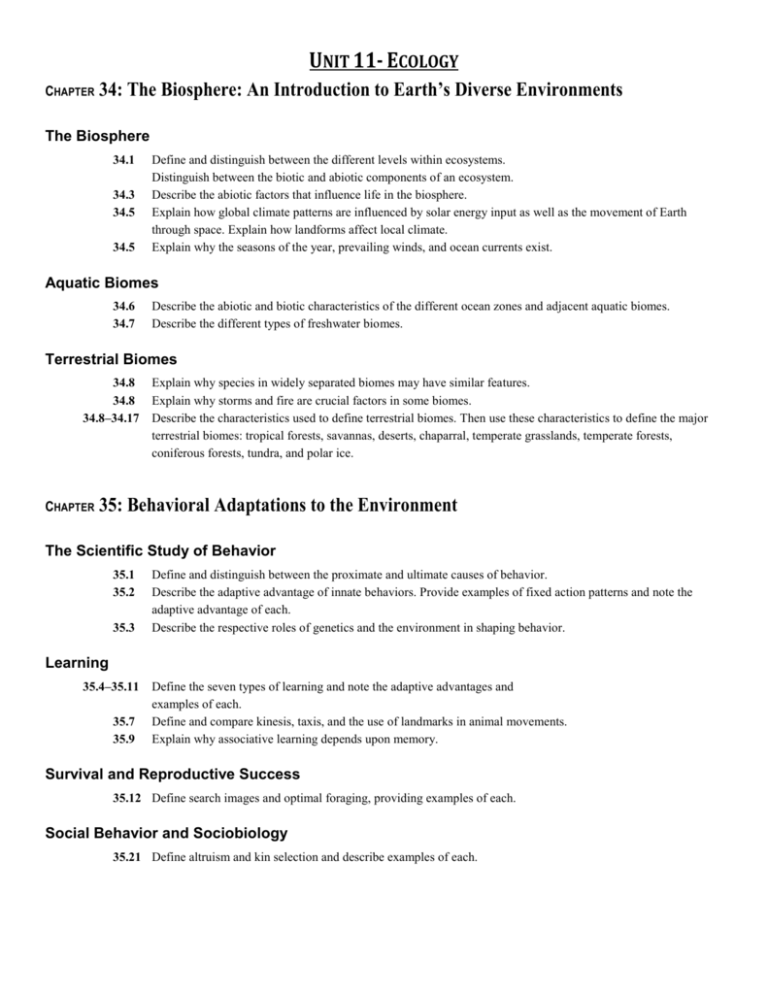
UNIT 11- ECOLOGY CHAPTER 34: The Biosphere: An Introduction to Earth’s Diverse Environments The Biosphere 34.1 34.3 34.5 34.5 Define and distinguish between the different levels within ecosystems. Distinguish between the biotic and abiotic components of an ecosystem. Describe the abiotic factors that influence life in the biosphere. Explain how global climate patterns are influenced by solar energy input as well as the movement of Earth through space. Explain how landforms affect local climate. Explain why the seasons of the year, prevailing winds, and ocean currents exist. Aquatic Biomes 34.6 34.7 Describe the abiotic and biotic characteristics of the different ocean zones and adjacent aquatic biomes. Describe the different types of freshwater biomes. Terrestrial Biomes 34.8 Explain why species in widely separated biomes may have similar features. 34.8 Explain why storms and fire are crucial factors in some biomes. 34.8–34.17 Describe the characteristics used to define terrestrial biomes. Then use these characteristics to define the major terrestrial biomes: tropical forests, savannas, deserts, chaparral, temperate grasslands, temperate forests, coniferous forests, tundra, and polar ice. CHAPTER 35: Behavioral Adaptations to the Environment The Scientific Study of Behavior 35.1 35.2 35.3 Define and distinguish between the proximate and ultimate causes of behavior. Describe the adaptive advantage of innate behaviors. Provide examples of fixed action patterns and note the adaptive advantage of each. Describe the respective roles of genetics and the environment in shaping behavior. Learning 35.4–35.11 Define the seven types of learning and note the adaptive advantages and examples of each. 35.7 Define and compare kinesis, taxis, and the use of landmarks in animal movements. 35.9 Explain why associative learning depends upon memory. Survival and Reproductive Success 35.12 Define search images and optimal foraging, providing examples of each. Social Behavior and Sociobiology 35.21 Define altruism and kin selection and describe examples of each. CHAPTER 36: Population Ecology Population Structure and Dynamics 36.1 36.2 36.3 36.4 36.5 36.6 36.7 Define a population and population ecology. Describe the general type of work performed by population ecologists. Define population density and describe different types of dispersion patterns. Explain how life tables are used to track mortality and survivorship in populations. Compare Type I, Type II, and Type III survivorship curves. Describe and compare the exponential and logistic population growth models, illustrating both with examples. Explain the concept of carrying capacity. Describe the factors that regulate growth in natural populations. Define boom-and-bust cycles, explain why they occur, and provide examples. Explain how life-history traits vary with environmental conditions and with population density. Compare rselection and K-selection and indicate examples of each. The Human Population Explain how the structure of the world’s human population has changed and continues to change. Describe the key factors that affect human population growth. 36.10 Explain how the age structure of a population can be used to predict changes in population size and social conditions. 36.11 Explain the concept of an ecological footprint. Describe the uneven use of natural resources in the world. 36.9 CHAPTER 37: Communities and Ecosystems Community Structure and Dynamics 37.1 37.2 37.3 37.5 37.6 37.8 37.9 37.10 37.11 37.12 37.13 Define a biological community. Explain why the study of community ecology is important. Define interspecific competition, mutualism, predation, herbivory, and parasitism, and provide examples of each. Define an ecological niche. Explain how interspecific competition can occur when the niches of two populations overlap. Define predation. Describe the protective strategies potential prey employ to avoid predators. Explain why many plants have chemical toxins, spines, or thorns. Define coevolution and describe an example. Identify and compare the trophic levels of terrestrial and aquatic food chains. Explain how food chains interconnect to form food webs. Describe the two components of species diversity. Explain why large fields of a single crop are vulnerable to devastating disease. Define a keystone species. Explain how disturbances can benefit communities. Distinguish between primary and secondary succession. Explain how invasive species can affect communities. Ecosystem Structure and Dynamics 37.14 Compare the movement of energy and chemicals within and through ecosystems. 37.16–37.17 Describe the movement of energy through a food chain. Explain why there are more producers than consumers and why eating meat counts as a great luxury. 37.18–37.21 Explain how carbon, nitrogen, and phosphorus cycle within ecosystems. 37.22 Explain how rapid eutrophication of aquatic ecosystems affects species diversity and oxygen levels. 37.23 Explain how human activities are threatening natural ecosystems.
